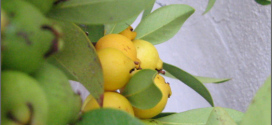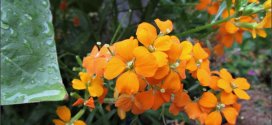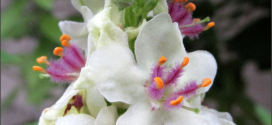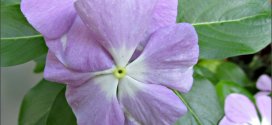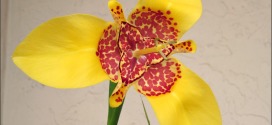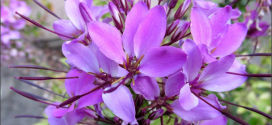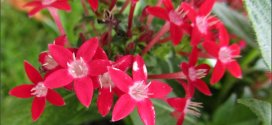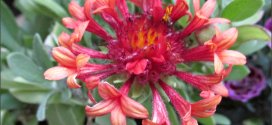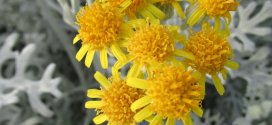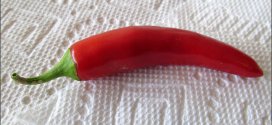Lemon guava (Psidium littorale (P. cattleianum lucidum), is similar to the strawberry guava except fruits are often slightly larger (1-2″). Flesh is yellow, very fragrant, with the suggestion of a lemon-guava like flavor. Guavas are tropical plants that produce sweet fruit that is high in vitamin C. Guava fruit is often made into jelly or preserves but can also be …
Read More »admin
Wallflower
From fast-growing clumps of strap-shaped foliage sprouted in early March, an abundance of bud clusters appear in April, which quickly pop open in an endless succession of very fragrant, absolutely neon-bright orange blooms well into mid-summer. Siberian Wallflower harmonizes beautifully with its fellow biennial Forget-Me-Not (Myosotis), the warm orange and cool sky blue. Despite the common name, Siberian Wallflower originated …
Read More »Verbascum chaixii
We first planted our verbascum in October 2014. It had a late season flowering. In June 2015, it bloomed again. Do not plant other things within 2 feet of it as it has large leaves. Erect stems bearing profuse saucer-shaped flowers that are usually yellow, but also white, brownish-red, or purple. Individual flowers are short lived but numerous, and flowering …
Read More »Vinca
Common Periwinkle, Creeping Myrtle, Flower-of-Death, Vinca minor Family: Apocynaceae (a-pos-ih-NAY-see-ee) (Info) Genus: Vinca (VIN-kuh) (Info) Species: minor (MY-nor) (Info) Category: Groundcovers Perennials Height: under 6 in. (15 cm) 6-12 in. (15-30 cm) Spacing: 15-18 in. (38-45 cm) Hardiness: USDA Zone 4a: to -34.4 °C (-30 °F) USDA Zone 4b: to -31.6 °C (-25 °F) USDA …
Read More »Tigridia
Tigridia, Tigridia alpestris Family: Iridaceae (eye-rid-AY-see-ee) (Info) Genus: Tigridia (ty-GRID-dee-uh) (Info) Species: alpestris (al-PES-triss) (Info) Category: Bulbs Perennials Height: 18-24 in. (45-60 cm) Spacing: Unknown – Tell us Hardiness: Unknown – Tell us Sun Exposure: Full Sun Danger: Unknown – Tell us Bloom Color: Purple Maroon (Purple-Brown) Bloom Time: Unknown – …
Read More »Cleome – Senorita Rosalita
Spider Flower, Spider Legs, Grandfather’s Whiskers, Cleome houtteana Family: Cleomaceae Genus: Cleome (klee-OH-me) (Info) Species: houtteana (hoot-AH-na) (Info) Synonym:Cleome hassleriana Synonym:Cleome sesquiorygalis Synonym:Tarenaya hassleriana Synonym:Cleome spinosa Synonym:Neocleome spinosa Category: Annuals Height: 36-48 in. (90-120 cm) Spacing: 18-24 in. (45-60 cm) Hardiness: Not Applicable Sun Exposure: Full Sun Danger: Plant has spines or …
Read More »Pentas – Scarlet Red
Pentas are tropical blooming plants. When you know how to grow Pentas, you have a foolproof way of attracting hummingbirds and butterflies, too.
Read More »Blanket Flower – Fanfare Blaze
Blanket Flower, Indian Blanket, Gaillardia, Gaillardia aristata Family: Asteraceae (ass-ter-AY-see-ee) (Info) Genus: Gaillardia (gay-LAR-dee-uh) (Info) Species: aristata (a-ris-TAH-tuh) (Info) Category: Perennials Height: 12-18 in. (30-45 cm) 18-24 in. (45-60 cm) Spacing: 15-18 in. (38-45 cm) Hardiness: USDA Zone 2a: to -45.5 °C (-50 °F) USDA Zone 2b: to -42.7 °C (-45 °F) USDA Zone 3a: …
Read More »Dusty Miller
Dusty miller is a favorite because it looks good with everything. The silvery-white color is a great foil for any type of garden blossom and the fine-textured foliage creates a beautiful contrast against other plants’ green foliage. Dusty miller has also earned its place in the garden because it’s delightfully easy to grow, withstanding heat and drought like a champion.
Read More »Chile – Cayenne Red
Cayenne is a green or red hot chili pepper used to flavor chile food dishes and is also used for medicinal purposes. Named for the city of Cayenne in French Guiana, it is a cultivar of Capsicum annuum related to bell peppers, jalapeños, and others. The Capsicum genus is in the nightshade family (Solanaceae). The fruit is typically dried and …
Read More »